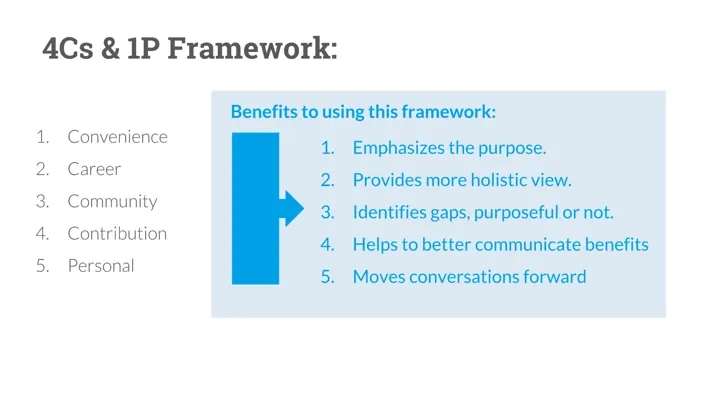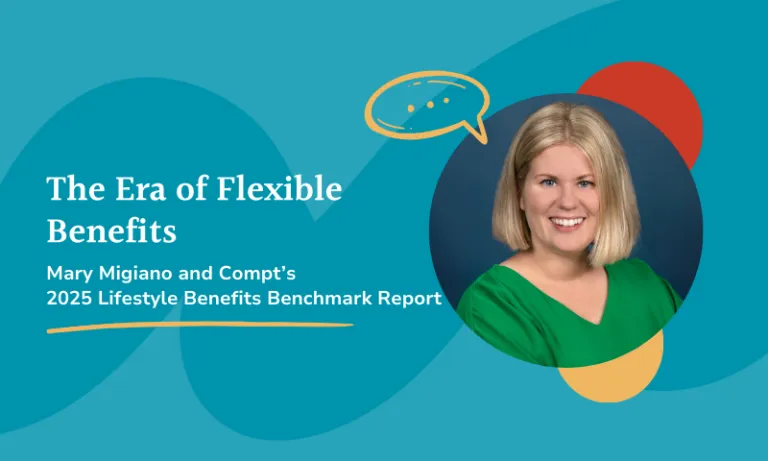What’s in this guide?
This comprehensive guide covers everything related to employee perks, from the unique perks your employees are sure to love to best practices and insights into the future of perks in the workplace.
1. What are Employee Perks?
Before we can dive into all of the things you’d need to know about perks, we first should define perks by answering the simple question, “what exactly are perks?”
Definition of Employee Perks:
Employee perks are non-wage offerings beyond salaries and benefits (such as health insurance, dental, vision, etc.).
They’re often called fringe benefits too.
Perks are ways to support employees beyond their standard salary and benefits. There are multiple types of perks, such as purchasable, programmatic, and environmental perks.
- Purchasable perks include perks purchased by the company, such as catered lunches, books, fitness stipends, pet insurance, and student loan reimbursement.
- Programmatic perks are policy-driven advantages to working at a specific company, such as remote work opportunities, pet-friendly offices, or offering Summer Fridays.
- Environmental perks are how you set up your office, including meditation rooms and slides.
What perks are not:
- Perks are not a health care, dental, or vision package. Those are benefits.
- Perks are not essential company hygiene factors like mission, vision, values, fair pay, or a strong/ethical team.
- Perks are not equivalent to company culture but are an important component of creating the culture.
- While it’s really great if you work close to where you live, it wouldn’t be considered an ’employee perk,’ even if you’re working from home.
Psst: Read full definitions of compensation, salary, benefits, perks, perk stipends, and more here.
Perks are Part of a Total Compensation Package — Not a Replacement.
Employee perks are part of a total compensation package. They’re not meant to replace other types of compensation, like a competitive salary, bonus structure, or benefits. Employee perks are the extra things employers offer that show employees how much they value them as individuals with other needs outside of work.
Great perks can help top candidates choose between two employers who may offer similar salaries and benefits, and they can also help employees feel more supported and engaged on the job.
However, offering a wide variety of employee perks can’t make up for unfair compensation or lousy benefits.
More on the Definition of Perks:
Almost everybody understands how salaries, bonuses, and benefits work.
But employee perks? Not so much.
Perks have been loosely defined since their inception, and this is a surprisingly serious issue.
Why?
No definition for perks = no progress.
Without a precise and agreed-upon definition, our conversation about perks becomes confusing. We can’t discuss their role because nobody is on the same page, which means we certainly can’t solve their issues.
A prime example of misunderstanding perks is the not-so-distant past when people claimed company perks were equivalent to company culture or that simply adding a few fun perks could transform a toxic culture.
The lack of a clear definition has made it easy for perks to be stretched, pulled, and applied in many different directions to solve other organizational problems.
This has resulted in company perks becoming the quick, easy, and inexpensive ‘go-to’ solution for organizational culture issues.
Let’s be clear; we do not think perks should be used for these purposes.
The incorrect application of perks has led to their being widely misunderstood and disliked by both employers and employees.
Fortunately, those days are close to being over.
The industry has come a long way in the past decade. The reasons companies offer perks as well as the lifestyle benefits they’re seeking, are much more altruistic and impactful on employees’ lives.
However, we think there’s still room for improvement.
It’s time we reimagine how company perks can contribute to an employee and a company because right now they’re barely scratching the surface.
Want to learn how we can help you build, manage, and streamline perk stipends so your employees can get what they need most?
Watch this video.
80% of employers say that meeting the needs of employees across all life stages and the diversity spectrum is an important benefits objective.
Half (51%) of employees reported receiving new or increased benefits since August 2021, when the Great Resignation began.
4 in 5 employees want benefits or perks more than a pay raise.
Glassdoor Employment Confidence Survey.
2. List of Employee Perks
If your goal is to continue with traditional perks programs, below is a short list of the perks that you can expect your people to want.
- Adoption assistance
- Career coaching services
- Casual dress
- Catered lunches
- Cell phone stipends
- Charitable matching
- Childcare (in-office support or subsidized)
- College loan repayment services
- Commuter stipends
- Company outings
- Conferences & training
- Continuous learning stipends
- Culture events & initiatives
- Diversity programs
- Employee stock purchase plan
- Employee discount programs
- Equipment/tech stipends
- Family medical leave
- Game room
- Generous parental leave
- Gym membership
- Happy hours
- Health & wellness stipends
- Lifestyle spending accounts
- Meditation rooms
- Meal allowances
- Online learning classes, courses, and certifications
- Onsite gym
- Performance bonus
- Pet-friendly office
- Pet insurance
- Professional development
- Recreational clubs (company-sponsored teams)
- Relocation assistance
- Remote work opportunities
- Remote work stipend
- Sabbatical leave
- Software stipends
- Stocked kitchen (snacks & drinks)
- Tuition reimbursement
- Unlimited vacation
- Volunteer time
- Wellness programs
Want to see a full list of perks that engage your employees? Then check out our comprehensive list of top perk vendors.
3. Benefits of Employee perks
There are a lot of advantages to offering employee perks in 2025. Below are just a few of the most compelling points:
- Perks make employees more productive and happier.
- Perks help attract, engage, and retain superstar talent.
- Company perks are not the only ingredient in employee engagement, but they help.
- Investing money to keep employees is cheaper than hiring new employees.
- Perks reinforce and strengthen the company’s purpose, values, and culture.
- Perks are a relatively inexpensive way to support employees beyond salary.
1. Perks are employee benefits that make people more productive and happier.
If the amount of press coverage of company perks indicates their impact within organizations, they’re transformative.
A quick Google search for company perks will result in articles covering the “best unique employee benefits for 2024,” with perks that appeal to everyone from recent grads to working parents. While there’s not much research strictly tied to company perks and their impact on business outcomes, ask any recruiter about their conversations with potential employees, and they’ll talk about the importance of offering perks.
If you take a step back, you’ll see what matters is not the actual perks that matter; it’s what they signify. They show a company’s willingness and desire to support their employees and their goals, beyond simply getting the job done.
Sure, employees want free coffee, pet insurance, and in-office showers with towel service. However, they really want to have better, more productive, balanced, and happier lives and to work for a company that supports them in building those lives.
Employee happiness is excellent for an organization’s bottom line. Studies have shown that when employees are happy, they’re 13% more productive, which improves performance across the board—and can lead to an increased stock price for public companies.
Clients do not come first. Employees come first. If you take care of your employees, they will take care of the clients.
— Richard Branson.
2. Perks help attract, engage, and retain superstar talent.
We’re clearly in a war for talent. The unemployment rate is at an all-time low, and the gap between the skilled labor necessary to complete a job and the labor available is rapidly increasing. These two factors drive companies to do everything they can to attract, engage, and retain top employees, and offering company perks is a standard way employers accomplish their hiring and retention goals.
We’re preaching to the choir here, but hiring the right people for the job is challenging. In fact, 76% of hiring decision-makers say attracting quality candidates is their #1 challenge.
Why is there such a significant emphasis on quality talent? Every organization wants high-performing employees, and top-quality candidates often have unique interests and priorities. Gallup research suggests that employers study top talent within the organization to ensure that recruiting messaging and experiences align with what the right candidates will be drawn to.
3. Company perks are not the only ingredient in employee engagement, but they help.
Today, salary ranges are transparent. It’s easy for any employee to pull up Glassdoor and have an idea of what they’re worth and how much they can expect an employer to pay them. This transparency in tight labor leads employees to look to other elements of the organization to know if they’re the right career home for them for the foreseeable future.
Insightful research from Adam Grant states that employees only care about three things: career, community, and cause. These three are directly related to an employee’s ability to grow in their career, feel like they belong and are respected, and work on a mission or cause they believe in.
Patrick Lencioni’s book, The Truth About Employee Engagement, boils employee happiness down to three similar items:
- to feel like you matter
- the work you do has an impact
- and that you’re making progress
Many of today’s perks support people’s journey toward achieving these deep desires. Company perks like book clubs, Toastmasters memberships, company-sponsored sporting teams, or even ocassionally paying for happy hour can develop an internal community.
Additionally, continuous education and training help team members grow and achieve more in their careers, helping them to have a more significant impact on their company’s mission.
Company perks are not the only ingredient in employee happiness and engagement. A carefully crafted perk program can be more strategic in fulfilling employees’ needs than people realize because it is a lifestyle benefit that goes beyond basic benefits.
4. Investing money to keep current employees is better than investing in hiring new ones.
When talented employees are happy, organizations win. As pointed out above, happy employees are more productive. They also tend to stay at their companies longer, making employee retention an essential focus for companies.
According to Kronos and Future Workplace research, 87% of HR leaders consider retention a critical or high priority over the next five years. And rightly so. Pre Pandemic research by Gallup puts the cost of replacing an individual employee at one-half to two times the annual salary of that position, with employee turnover costs totaling a trillion dollars for U.S. companies. With the increased challenge of hiring amid a talent shortage, those costs could climb even higher this year.
Many employee perks are low or even no cost to employers. However, even perks that come with a price tag pale in comparison to the rising costs of employee turnover. Investing in your current employees, and creating a more satisfying and rewarding work environment can save you thousands — or more — down the line.
5. Perks reinforce and strengthen the company culture.
For too long, company perks have been added to companies without too much strategic thought behind them.
They’ve slipped into a reactionary mindset. “Everyone wants yoga, so we’re offering yoga” and “Everyone is offering ice coffee and kombucha on tap, so we should too.” As HR strives to become the strategic partner to leadership, as Dave Ulrich mentioned in Human Resources Champions, it’s essential to zoom out of the day-to-day operational focus and offer a strategic approach to perks that provide a competitive edge for the company.
One method of becoming a strategic partner is offering perks that do more for the business and its employees by proactively strengthening its unique purpose or core values.
Perks should reinforce values like empathy and learning or principles like “never eat alone,” which are powerful ways to translate what matters to the company into employees’ everyday lives.
What results is an even more pronounced and positive culture.
This reinforcement is seen on a micro level in the differences between employees collaborating over lunch vs. eating in silos. It’s the difference between employees comfortably owning their failures vs. sweeping them under the rug. It’s the difference between your LGBTQ+ team members being comfortable bringing their whole selves to work versus feeling withdrawn or even alienated.
Here are examples of ways that companies can reinforce their unique culture:
- If you are a digital health company, offer health and wellness benefits.
- If you are a fertility company, family-planning benefits are appropriate.
- If you’re a travel and hospitality company, tie perks to your mission. Airbnb provides employees with a travel allowance of $2,000 a year. The caveat is that they must stay with an Airbnb host while traveling to experience life as their customer would, which develops greater empathy and understanding of their customers and their needs.
- If you have an ‘always be learning’ value, strengthen it by investing in a books program, an annual conference budget, or bringing outside experts to the office to offer educational workshops or activities to learn and grow.
Through perks, a company invests in clearly communicating to its employees what matters to the organization and what behaviors they value.
Make sure you’re thinking about your perks program strategically to differentiate yourself from competitors vying for talent.
6. Perks are a relatively inexpensive way to support employees beyond salary and health insurance.
Instead of increasing everyone’s salary, company perks can offer more value.
Making employees happy doesn’t necessarily require a salary increase, especially if their salary is already at a point that leads to a high quality of life. As Daniel Pink’s book Drive suggests, once people meet a certain level, they can focus on intrinsic motivational factors such as mastery, autonomy, and purpose. And offering the right perks can even convince your people to spend more time working on-site if that’s what your business needs. A 2022 survey of office workers revealed the most wanted perks as fitness perks, such as yoga studios and office gyms (46%) and access to a designated quiet space (44%).
Perks can enhance employees’ lives in many ways that more money cannot, such as adding convenience, continuing their education to advance their careers, caring for their families in ways they might not be able to alone, contributing more to others, and developing a greater sense of community.

Perk stipends: the Best Company Perks?
Have you heard of perk stipends yet? They empower HR to craft custom programs that enable their people to purchase the perks they want and need most.
In the example above, Sam’s company allocated $100 per month to spend the following perk stipends: learning, health & wellness, and food.
What would you buy with your $100/month for perks?
Download Perk Software Buying Worksheet
Whether you’re selecting individual perks, debit cards, or Compt’s stipends, our goal is to help you choose the best perks program for your situation.
4. How to select the best company perks
Not all company perks are created equal.
That’s why we’ve created the 4Cs and 1P framework, which we’ll explore below.
It’s a tool that HR managers use to ensure they approach employee perks thoughtfully and proactively.
We aim to help companies everywhere find balance and inclusion in their perks. We talked with many HR professionals about their perks programs. From these conversations, we noticed four distinct methods for considering perks and selecting the best ones for an organization.The first thing to consider when offering perks is their purpose.
1. First, consider the perk’s role or purpose
Each perk has a purpose — i.e., the reason it’s being implemented at an organization.
Reflect on the difference between offering your employees catered lunches versus conference allowances.
The purposes of perks can be divided into five distinct categories, which we refer to as the 4C and 1P: Convenience, Career/Continuing Education, Community, Contribution, and Personal/home life.

Convenience
Convenience perks are about adding comfort to an employee’s life. For example, not having to leave work to accomplish essential errands can be a huge time saver. There are two types of convenience perks: those employees pay for and those they don’t.
Perks like in-office dry cleaning, car washing, and manicures are brought into the office to save the employee’s travel time or organizing, but they’re still often paid for by the employee. Company-paid convenience perks include catered lunches, office snacks, and coffee bars.
Continuous education/career
Education perks aim to assist employees in developing further mastery of their craft. When employees learn more, they’re more intrinsically motivated, productive, and happier, and that positivity flows throughout their work. Whether they’re leaders or someone who leads without the title, this positivity can be contagious and permeate other employees and their work.
This type of perk includes conferences, book programs, paid online training or seminars, and professional organization memberships.
Community
While most people don’t realize it, the community element can have a tremendous impact when it comes to selecting perk options. Perks like in-office yoga or meditation sessions, extracurricular sporting teams, or happy hours lead to increased community and personal growth among employees.
Community is a sense of connection and belonging. The community is feeling respected and cared about.
Perks like in-office yoga or meditation sessions, extracurricular sporting teams, or happy hours lead to increased community and personal growth among employees.
Contribution
We define this as supporting employees in their contributions to helping causes.
Contribution-categorized perks could include creating a policy around volunteer days, running a company-wide charity like bringing canned foods for the hungry or school supplies for needy children, and even offering matching programs for charitable giving.
Those are the main purposes that most perks have, though some might not fit squarely into a particular category. Often there’s overlap, which is excellent.
If you can find perks that fulfill multiple purposes, you can offer more value to your employees and give them the best possible experience.
Though the purpose is an important idea to keep in mind when selecting perks, it’s not the only one. There are still costs, employee use, and the impact that still have to be considered.
Personal/home-life
Personal or home-life perks apply to the perks that employees use outside of the office to make them more balanced, fulfilled, and whole, which will positively impact their work. This includes discounts on gyms or health and wellness perk allowances. It also includes perks such as tuition assistance, pet insurance, daycare support, or egg-freezing.
Wellness Programs
Wellness programs are great for employee satisfaction and one of the best company perks you can offer. Design your employee perk program to center on wellness, and you’ll see more engaged teams. More engaged teams mean lower employee turnover and a much better environment.
2. Next, think about how much perks cost
Perks can range anywhere from free to thousands of dollars per employee.
While we believe company culture shouldn’t be about the size of your wallet but the size of your heart, it’s true that companies with bigger pockets can offer more expensive and specialized perks.
That’s why large organizations can afford to cover tuition reimbursement, egg freezing and other fertility treatments, and gender-affirming surgeries.
If you’re an organization with a tight budget, company perks are not out of reach. However, they might require more creativity and come as a company culture initiative.
Instead of offering gym passes or installing an on-site gym, develop a free “100 Push Up Club,” create a company-wide 30-day challenge where everyone picks their own goal, or develop a fitness contest where the winner receives a prize like a Fitbit or a pass for a free massage.
3. Consider how many employees they’ll support
Thinking that all perks will apply to everyone is an outdated line of thinking.
When perks were brand new, and everyone was happy to have something extra in their office, people appreciated everything and anything.
As more companies offer perks and the employee experience becomes increasingly personalized, employees want perks customized to them and their needs.
Take providing beer, for example. While beer used to be an excellent starting point for offering perks, there is rarely an office where everyone drinks beer. Some people are gluten-free, prefer wine, are new parents, and would prefer some other investment with that perk money, or are remote employees who cannot enjoy this perk.
Apply this approach to all of your perks, and you will quickly see how lopsided your offering can become.
When thinking about your perks, be sure to honestly assess how many people and who they’ll apply to. Remember to consider your remote team, too.
4. Lastly, consider the impact they’ll deliver to an individual and the organization
Perks have different types of impact and varying levels of impact.
With company perks, often there are two approaches to impact: proactive and reactive.
Proactive perks are offered because the company is proactively trying to align with new company values or industry trends.
Reactive perks happen when companies offer perks in response to their competitors or the industry or realize that they need to address a need within their company.
An example of the latter type of reactive perks is a company that notices that its team isn’t staying up on their craft. In this case, the company might institute a book program, a book club, or even give everyone a couple of hours of ‘learning time’ per week to help them improve their skills.
Some of the other considerations addressed less often when it comes to picking a perk are:
- how easy it is to implement
- the time it takes to manage
- and how it will scale as the company grows.
Ultimately, before deciding on your company’s new office perk, it’s important to know what goal you’re trying to accomplish and where it falls on a spectrum of money, employee application, and impact.
To learn more about which perks would be best for your team, check out Top Innovative Perks.
Receive a Perks Program Review
Are your perks not accomplishing their goals anymore? It could be time for an update.
Receive a Perks Program Review
Or complete one yourself
5. Problems with Perks Today
Perks as a talent strategy have been around for a while, and as their role and significance inside organizations increase, so have the problems associated with them:
They’re no longer innovative, they’re required.
With the unemployment rate at an all-time low in the United States and the skills gap increasing, top talent is more difficult to attract than ever. Companies are turning to perks to stand out from the competition. Offering perks was once an innovative strategy, but companies of all sizes and budgets have since adopted this approach.
As Kirsten Pollard, Chief People & Culture Officer at OFX, puts it:
“[The basic perks] are more than important, they’re essential. The competition to retain talent is rife, and perks are expected these days.”
They are now challenging to manage and maintain.
Regardless of whether you offer two or 20 perks, someone on your team (maybe you?) will have to pick, purchase, and maintain them for the team. Today, most people use email filtering and spreadsheets to keep track of this, which is an inefficient and time-consuming model.
If you feel this pain, learn more about the Perks Tipping Point to see how you can address it.

Their adoption is growing, but the models of offering them haven’t kept up.
Unlike many other industries, perks have no frameworks or processes defined for how companies should pick them. Most people rely on prior knowledge, experience, and those around them.
If you’re looking for a new approach, check out lifestyle spending accounts which are the new approach many companies are taking.
The research on them and their impact is still minimal.
Because they are often combined with benefits in research studies, they have not been adequately considered.
To combat this, we’ve begun pulling together a big list of perk statistics.
There aren’t any ‘perfect’ or ‘best’ perks.
Many articles online tout ‘the best’ company perks, but the truth is that everyone’s preferences, wants, and needs are different. On top of that, what someone might need today regarding health & wellness or continuous learning might be completely different in six months.
Lastly, the perks standard is being set by big players with big budgets.
We think company culture shouldn’t be about the size of the company’s budget but rather about the size of the company’s heart.
With big-budget companies having unlimited opportunities to buy perks, smaller companies must be more creative than ever before if they want to compete.
Here are a few examples of employee perks that large employers offer:
- Microsoft: a host of well-being perks, including wellness stipends, financial planning, on-campus services, Employee Resource Groups, and expanded family benefits and professional development opportunities.
- Google: Free food, dog-friendly workplaces, on-site fitness centers, nap pods, floating wellness days, and stipends for new parents.
- Visa: donation matching, PTO and cash incentives for volunteering, education programs, and tuition support
Additional reading:
- The Number of Perks is Growing and So Are the Problems They Create
- 6 Ways Your Perks Might Be Failing (Even If You Offer Indoor Rock-Climbing and an Espresso Bar)
- How to Change or Consolidate Your Perks
6. The Future of Company Perks
What does this year have in store for employee perks? We set out to answer that question. We recently interviewed passionate, people-first folks in the people operations industry, including managers, tech CEOs, and culture software owners, and asked them to share their thoughts.
Below are the employee perk trends that bubbled to the top:
- Evolution away from basic amenities to more meaningful perks
- Emphasis on flexibility and personalization
- An expanding use for perks
- More companies offering more perks
As Baby Boomer employees retire, more Generation X (and Y) will face the challenges of balancing their parents’ and grandparents care with their careers, often on top of their own immediate family. Employers can help by offering expanded perks related to caregiving roles, such as childcare and elder care services or reimbursements, additional time off, flexible work hours and location, and even stipends to help supplement other caregiving costs.
A parting thought…
“Culture eats strategy for breakfast.” – Peter Drucker
Company perks are still in the early innings for their use in companies everywhere. As the talent market continues to tighten, and the percentage of Gen Z and millennials in the workplace increases, companies will continue to turn to perks as strategies to enhance their culture, differentiate themselves, and make a meaningful impact on the lives of their employees.
This post was originally published in 2019, but has been updated recently for clarity and relevance for our readers.







